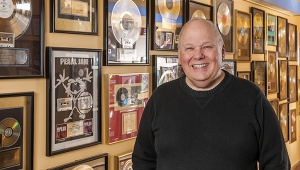| Columns Retired Columns & Blogs |
Paul McGowan: High-End Survivor
"I don't believe it!"
I had just unplugged my preamplifier from the PS Audio Power Plant P300 and powered it from the wall socket, and was reacting to the resultant "grayness" that had been reimposed on my music. We seem to be more sensitive to hearing subtle but ultimately important sonic effects when they are removed than when they are introduced—as I describe in this issue's "Follow-Up," the AC regeneration offered by the Power Plant strips away a veil from the sound of my system and increases the saturation, the contrast of instrumental colors. It does this in a way that proved addictive, to my checkbook's detriment.
AC regeneration is not new to high-end audio. I first heard its effect in the mighty Mark Levinson No.33 Reference amplifiers, and in the Connecticut company's more recent No.32 Reference preamplifier. But the PSA Power Plant is the first standalone component to offer what I have come to believe is a significant step forward in freeing audiophiles' systems from the effects of the often-contaminated AC flowing through their walls. So when PS Audio's Paul McGowan passed through Santa Fe just before Christmas 1999 on his way back from Texas to home base in Colorado, I asked him for a bit of oral history.
Paul began his audio career in 1974 as the "P" in PS Audio, and now is back in charge of the company that bears his initial. But for a while in the '90s he was a partner in speaker manufacturer Genesis Technologies, with industry veterans Arnie Nudell (Infinity) and Mark Schifter (Audio Alchemy and now Perceptual Technologies). I asked Paul what had triggered his return to his roots.
Paul McGowan: Arnie Nudell, Mark Schifter, and I are all very strong-willed people, each of us having been the president of our own company. We each had a slightly different idea of which way Genesis should be going. At the end of the day, instead of fighting the battle of taking the company in a direction that my two partners probably didn't want to go in, I found it easier to re-start up PS Audio. The name became available at a very fortuitous time. I grabbed hold of it, and with the blessing of my partners went off and did my own thing.
John Atkinson: Had problems with power supplies been lurking in your consciousness all these years?
McGowan: For a long time. Way back when Stan and I were partners—I was the "P" of PS Audio; the "S" was Stan Warren, who's off doing his own thing in Eugene, Oregon—I experienced a classic case of the value of listening to things as opposed to just trying to pencil everything out. We were just making preamps and phono stages, I don't think we were making a power amp at the time, and Stan called me into the listening room saying, "You've gotta hear this."
He sat me down and played me an LP.
I said, "Yes, that sounds fine."
Then he did a classic A/B—it was one of the biggest jaw-droppers I've ever heard.
"What the heck did you do?" I asked. We were listening to a phono stage, and I figured he'd done something to the circuit, because each one of us was playing around with circuits at the time.
"I changed the transformer!" he said. "I couldn't find the appropriate small little weeny preamp transformer we would normally hook up, but I found this large power-amp transformer that happened to be exactly the same voltage. I hooked it up and you heard the difference."
The only thing he did was change the transformer. We went from a 100mA transformer to a 10A transformer—exactly the same voltage, the circuit was drawing no more current—and the difference was just staggering. To this day it's one of the biggest differences I've ever heard.
We scratched our heads, we asked everybody we could, but neither of us had a clue why we could hear such a big improvement from the bigger transformer. We couldn't measure any difference, but we said, "What the heck, it works." So we began producing what we called the "High Current" power supply, an add-on box. We built 'em for years, actually, before we finally figured out what was happening. Which was the large transformer's very low secondary impedance, maybe under an ohm, whereas it's of the order of 35-50 ohms for a small transformer with the same voltage.
But it was that experience maybe 20 years ago that got me thinking about how important power supplies were. That's when I first concluded that it's wrong to think of an amplifier circuit that is being driven by a power supply. It's more appropriate, in my opinion, to think in the opposite way: that a power amp is, in essence, a power supply being modulated by the amplifier circuit.
- Log in or register to post comments




































